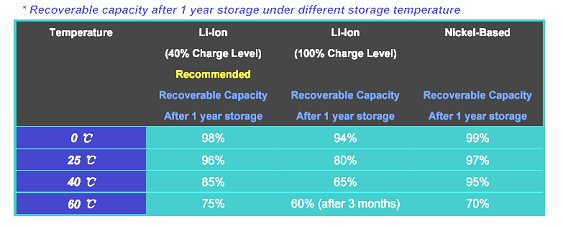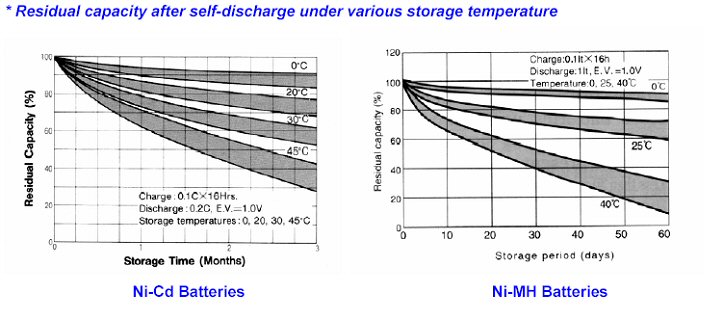| Battery Care Tips
Need help, advice or quality replacement batteries, please Contact Durham Communications.
|
|
Batteries are perishable products that start deteriorating right from the moment they leave the factory. It is often discovered that some failures of batteries can be caused by improper storage and handling. In order to ensure all batteries are properly treated and maintained, We recommend the following battery care tips for end users. These simple preventive measures can slow down a batteries aging process.
General Tips for Storage of Nickel and Lithium Based Batteries
► Keep batteries in a cool and dry storage area. Recommended storage temperature range is -20°C ~ 30°C and storage humidity is 65±20%. Keeping batteries outside the specified range may result in leaks and rust caused by cell expansion and contraction.
► Avoid connecting the batteries to the host (equipment) when they are stored for a prolonged period of time; it may result in cell leakage.
► Avoid dust piling on batteries during storage, especially on the battery terminal area.
► Do not fully charge lithium and nickel-based batteries before storage. Keep them partially charged and apply a full charge before use.
Recommended state-of-charge for nickel-based and lithium-ion batteries storage is about 40% (3.75-3.80V/cell open terminal for Li-ion batteries; Voc cannot be used for determining state-of-charge for nickel-based batteries).
|
|

|
Operation
|
• Do not expose battery packs to mechanical shock.
• Always try to keep your battery pack dry.
• Make sure that the battery pack is attached to the host (radio equipment) securely.
• To prevent an accident from a short circuit, do not allow metal objects such as keyrings,coins, etc to come into contact with the battery terminals.
• Let your batteries charge fully. Never interrupt a charge cycle.
• Keep battery packs away from high heat, fire and direct rays from the sun.
• Never expose battery packs to temperatures above 140°F, such as in a car parked in the sun.
• Do not charge a battery when it is cold or in cold temperature (below 0°C).
• Do not disassemble or try to modify the battery pack. |
|
Nickel Cadmium (Ni-Cd) and Nickel Metal Hydride (Ni-MH) Batteries
|
| Charging and Cycling |
|
► Never leave a nickel-based battery sitting on a charger for more than a few days, even on a trickle charger. Prolonged trickle charge causes crystalline formation (memory effect).
► Recharge your battery when your equipment signals “low battery”. Failure to “deep cycle” batteries will result in “memory” build-up. This can significantly reduce your battery’s run time as well as shorten the battery’s overall cycle life. Periodic discharge (recommended once per month, running down battery on the equipment will also do) to 1V/cell is essential.
► Stabilize battery to room temperature (22°C/72°F.) before charging. Charging below 4.4°C / 40°F or above 40°C / 104°F will decrease cycle life.
► Cycling (Priming) is recommended to regain lost capacity after a nickel-based battery has been stored for 6 months or longer. Cycling can be achieved by applying a slow charge followed by one or several discharge/charge cycles. The recovery rate is governed by the condition under which the battery was stored. The longer and warmer the storage temperature, the more cycles will be required. Excessive cycling should be avoided because of wear-down effect.
► Forming - Nickel-based batteries are not always fully formed when leaving the factory. Applying several charge/discharge cycles through normal use or with a battery analyzer completes the forming. The number of cycles needed to attain full capacity differs between cell manufacturers. Batteries assembled with high-quality cells from Japanese manufacturers perform to specification after 5-7 cycles. Others may need 50~100 cycles to reach acceptable capacity levels. The forming process is only required when the battery is new.
► Initializing - Initial batteries before placing into service for the first time. Let your battery stay in the charger approximately 50% longer than a normal charge (approximately 2-4 hours for rapid charger and 14-16 hours for a slow charger). Only initialize batteries on the first charge.
|
|
Storage
|
|

|
|
Typical shelf life for Ni-Cd batteries is 2-3 years. A Ni-Cd battery’s capacity will decrease by 10% in the first 24 hours, then decline to about 10% every 30 days thereafter. Typical shelf life for Ni-MH batteries is 2 years. The self-discharge rate for a Ni-MH battery is about 1.5~2 times greater than that of a Ni-Cd battery. For all nickel-based batteries, self-discharge will increase with higher temperatures.
• Ni-Cd batteries can be stored up to two years and Ni-MH batteries can be stored up to one year without suffering from significant cycle loss. If you plan to store batteries for longer than 90 days, charging your batteries every 90 days is highly recommended to maintain maximum capacity.
• When a nickel-based battery’s voltage drops below 0.8V/cell, normal desktop chargers (rapid and trickle) may not be able to activate the battery and complete a successful charge. These batteries must be cycled by specialized charging equipment/analyzer.
|
Lithium Ion (Li-ion) & Lithium Polymer (Li-Polymer) Batteries
|
| Charging |
|
► Do not attempt to recharge a Li-ion battery below 1.5V/cell for safety reasons.
► Charge Li-ion batteries often, except before a long storage. Avoid repeated deep discharges; there is no memory effect when unscheduled charges are applied. But excessive charge/discharge cycles should be avoided because of the wear-down effect.
|
| Storage |
|
► If a Li-ion battery is left discharged after use, the self-discharge will further drain the pack and eventually trip the protection circuit at about 2.5 volts per cell. At this point, the charger will no longer recognize the battery and the pack appears dead. Only specialized equipment or an advanced battery analyzer will be able to re-activate the protection circuit and recharge the battery. Charge for about 30 minutes before storage if the Li-ion battery is depleted.
► Do not stockpile lithium-ion batteries; and avoid buying dated stock. The aging process cannot be reversed and cycling will not improve.
► The self-discharge of the lithium-ion battery is 5% in the first 24 hours after charge, and then reduces to 1% to 2% per month thereafter. The safety circuit adds about 3%. High cycle count and aging have little effect on the self-discharge of lithium-based batteries.
|
|
Multiple factors can affect the overall reliability of a battery pack, so it is impossible to give an accurate prediction on a battery’s life. However, if all of the above procedures are followed and implemented precisely, then it is certain that most batteries can be maintained at an optimal performance level during their life time.
|
| Need help, advice or quality replacement batteries, please contact us. |
|
|
|
|



